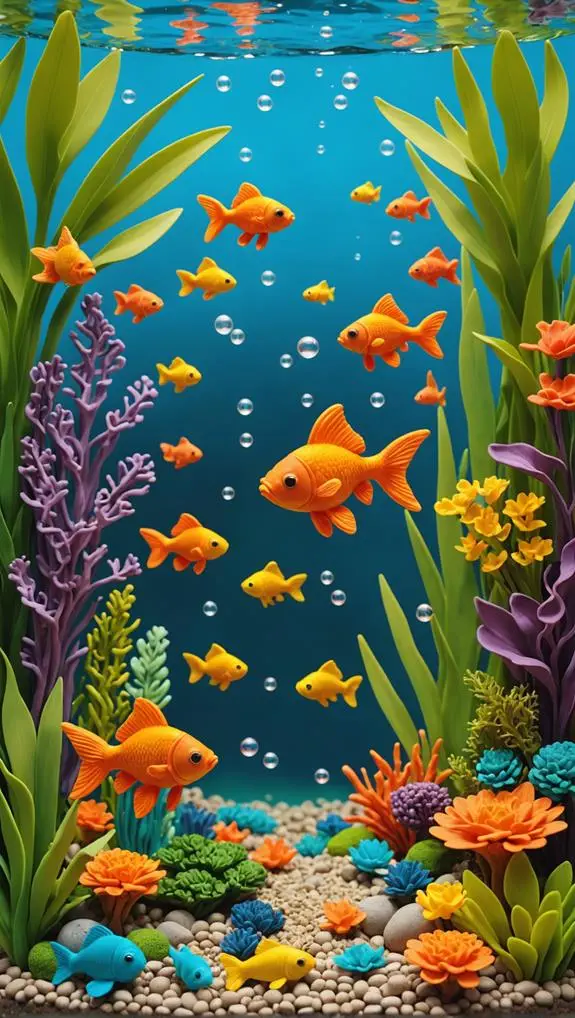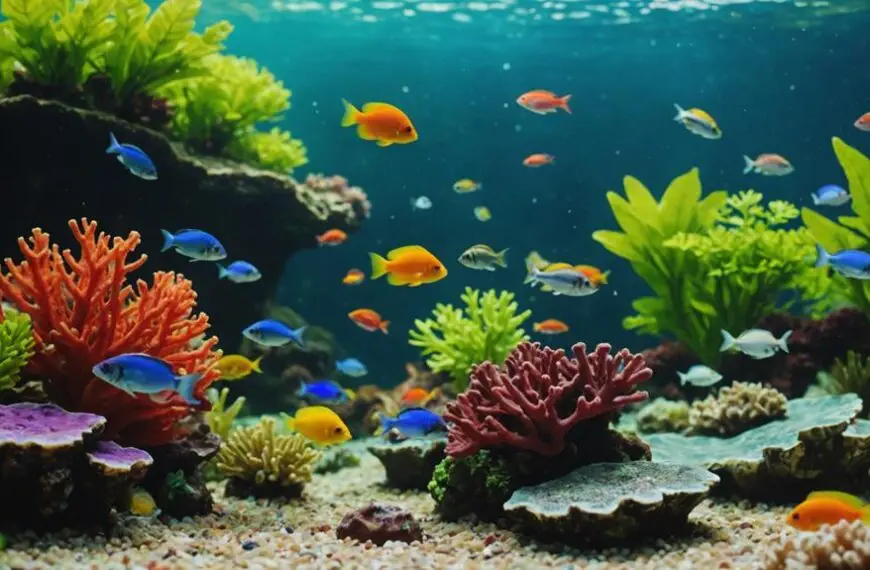Feeding your goldfish the right foods is super important for their health! They need a mix of high-quality flakes, sinking pellets, and some fresh veggies like blanched peas to really shine. You should aim for meals packed with protein and fiber, which keeps their digestive systems happy. Don't forget about those colorful treats like spirulina to make them look vibrant! Just remember, feeding a bit too much can lead to problems like obesity, so be sure to give smaller portions a few times a day. Stick around to discover more tips for keeping your slippery little friends in tip-top shape!
Contents
Nutritional Requirements for Goldfish
Nutritional requirements for goldfish are crucial for their health and vitality. To keep your little swimmers thriving, you need to provide them with a balanced diet. Adult goldfish should receive about 30% protein, while juveniles require around 35% to support their growth and energy needs. High-quality goldfish food is essential, so look for protein sources that are rich in fiber, vitamins, and minerals.
Recommended beginner fish can also benefit from varied diets that include fresh vegetables and high-quality flakes. Mixing up their meals helps keep things interesting! Offer a variety of food types, like pellets, flakes, frozen treats, and even fresh vegetables. This variety not only ensures a well-rounded diet but also prevents boredom in your fishy friends.
Just remember, overfeeding can lead to health issues, such as obesity and poor water quality, which can affect your entire aquarium environment.
Don't forget to sprinkle in some color-enhancing foods, like spirulina. These not only boost your goldfish's vibrancy but also contribute to their overall appeal.
Types of Goldfish Food
When it comes to feeding your goldfish, you've got a smorgasbord of options to choose from!
Each type of food, whether it's floating flakes, sinking pellets, or even fresh veggies, plays a unique role in keeping your little swimmer healthy and happy.
Understanding the nutritional value and variety of these foods can make a big difference in your goldfish's diet and overall well-being, so let's explore what works best for your finned friend!
Nutritional Value Overview
Goldfish need a well-rounded diet to stay healthy and thrive, and there are several types of food available to meet their nutritional needs. When feeding your goldfish, you'll want to focus on high-quality options that provide the right amount of protein.
Adult goldfish need around 30% protein, while juveniles require about 35%. Sinking pellets are a great choice, especially for fancy goldfish, as they help prevent buoyancy issues.
Don't forget to mix in some frozen foods like brine shrimp and bloodworms, which add essential nutrients and a bit of excitement to their meals.
Fresh vegetables, like blanched peas and leafy greens, are also important. They're full of fiber, which keeps your goldfish's digestive system happy and helps prevent constipation.
Steering clear of low-quality processed foods is crucial, too. These can lead to health issues and can mess with your aquarium's water quality.
Food Variety Importance
Providing a variety of foods is essential for keeping your goldfish healthy and happy. You wouldn't want your goldfish to get bored with the same old meal every day, would you?
A varied diet plays a crucial role in your goldfish's health. High-quality flakes are convenient, but for fancy goldfish, sinking pellets are often a better fit. They help prevent buoyancy problems, which can be a real hassle for your aquatic friends.
Don't overlook the benefits of frozen foods! Treating your goldfish to brine shrimp or bloodworms adds protein and excitement to their diet.
Plus, fresh vegetables—like blanched peas and leafy greens—provide essential fiber and nutrients that support digestive health. A balanced mix ensures your goldfish receive essential vitamins and minerals, keeping them vibrant and resilient against diseases.
Feeding Techniques Explained
A well-rounded diet isn't just about variety; it's also about the types of food you choose for your goldfish. When feeding goldfish, consider high-quality flakes, pellets, gel foods, frozen foods, and yes, fresh vegetables! Your fish need a mix to keep their diets exciting and nutritious.
For fancy goldfish, sinking food is often a better choice to help with buoyancy, while singletails enjoy both floating and sinking options.
Don't forget about the protein! Foods like bloodworms and brine shrimp pack a punch of essential energy and support growth. Adding fresh vegetables, like peas and blanched leafy greens, helps with your goldfish's digestive system, keeping things running smoothly and avoiding constipation.
Also, introducing spirulina and color-enhancing foods can make your goldfish's colors pop, while boosting their immune system.
And if you've got live plants in the aquarium, they can turn into a tasty snack too!
Recommended Feeding Practices

Feeding your goldfish the right way is crucial for their health and well-being. To keep your aquatic friends happy and thriving, aim to feed your goldfish 2-3 times daily with smaller portions.
Just give them what they can munch in 2-3 minutes—this helps prevent overfeeding and keeps water quality in check, as regular testing is crucial for maintaining fish health.
Mix up their diet with sinking pellets and flakes, but remember that fancy goldfish prefer sinking options to avoid buoyancy problems. Fresh vegetables, like blanched peas and leafy greens, add fiber and encourage healthy digestive systems. Think of it as a gourmet meal for your fish!
Keep an eye on your fish's behavior and health, adjusting the feeding schedule based on their activity and the water temperature. If they seem more active, they might need a bit more food.
And don't forget to remove any uneaten food promptly; you wouldn't want your goldfish dining in a messy environment!
Signs of Overfeeding
Overfeeding can quickly become a serious issue for goldfish, impacting their health and vitality. It's crucial to recognize the signs that your fish might be getting a bit too much food. When you feed your fish, keep an eye out for these warning signals: A bulging belly or broader midsection, decreased food-seeking behavior, sluggish swimming or unusual swimming patterns, excessive trailing feces or translucent droppings, and loss of appetite or changes in appearance.
Maintaining water quality is essential, as poor conditions can exacerbate health problems linked to overfeeding; therefore, regular maintenance like performing weekly water changes is important. These signs can indicate that your goldfish's digestive system is struggling. Obesity, for instance, can make it hard for them to swim properly and can lead to serious health issues like swim bladder disorder.
If your fish seems less active or isn't interested in food, it might be time to cut back. Remember, a healthy aquarium thrives on balance. Regular health checks will help you catch any issues early, allowing you to keep your goldfish happy and lively.
Benefits of Variety in Diet

Offering a varied diet is essential for your goldfish's health and happiness. Just like us, goldfish can get bored with the same old meals day after day. Mixing it up with pellets, flakes, frozen foods, and fresh vegetables keeps them engaged and encourages natural foraging behavior. This variety not only prevents boredom but also ensures they're getting a balanced mix of nutrients.
You want your goldfish to thrive, and incorporating foods rich in fiber, like peas and blanched greens, can help with digestion. This can reduce the risk of constipation and those pesky swim bladder issues.
Plus, don't forget about color-enhancing foods like spirulina! They can help your goldfish maintain their vibrant hues while boosting their immune response for long-term health.
Offering different textures and forms, such as floating and sinking options, caters to your goldfish's varied feeding habits, making mealtime more exciting.
Special Considerations for Goldfish Types
When it comes to feeding your goldfish, it's important to consider their specific needs based on their type.
Singletail goldfish are pretty tough and can handle a variety of foods, while fancy goldfish need a bit more care—think sinking pellets and plenty of veggies to keep them happy and healthy.
Singletail Goldfish Nutrition
To ensure your singletail goldfish thrive, understanding their unique nutritional needs is crucial. These fish have a robust digestive system, which means they can handle a wider variety of foods than some other goldfish types. A well-balanced diet helps keep them healthy and happy!
Here are some key points to remember:
- High-quality pellets: Choose sinking pellets to aid digestion and avoid buoyancy issues.
- Protein sources: Include brine shrimp, bloodworms, and spirulina to support their energy needs.
- Variety diet: Mix in dry food and occasional fresh vegetables like frozen peas and leafy greens to prevent boredom.
- Digestive health: A varied diet promotes better digestive health and keeps your goldfish feeling great.
- Active lifestyle: Their energetic swimming habits require more protein than you might think—up to 35% for juveniles!
Fancy Goldfish Feeding Needs
Feeding fancy goldfish requires special attention to their unique anatomical features and dietary needs. These charming little swimmers have compact bodies that can lead to buoyancy issues if you're not careful at feeding time.
It's best to use sinking pellets instead of flake food, as this helps keep their goldfish digestive system happy and healthy. A high-fiber diet is essential, too! Incorporating blanched peas and leafy greens can work wonders for preventing constipation.
Remember to feed them small amounts, about two to three times a day, ensuring they finish their meals in just 2-3 minutes. This helps minimize waste and keeps your water temperature stable.
When it comes to protein content, aim for around 30%. This supports their growth without leading to obesity. If you have juvenile fancy goldfish, a bit more protein can be beneficial.
Don't forget to choose high-quality brands with natural color enhancers like spirulina, which will keep your fish vibrant and lively. With a little care and the right food, your fancy goldfish will thrive, and you'll enjoy their beautiful colors every day!
Frequently Asked Questions
How Do I Keep My Goldfish Healthy in My Aquarium?
To keep your goldfish healthy, ensure proper tank maintenance, monitor water quality, regulate temperature, and provide suitable lighting. Create a stress-free environment with appropriate decorations, a balanced feeding schedule, and compatible tank mates for disease prevention.
How Can I Improve My Goldfish Health?
You think goldfish just float? Improve their health by ensuring optimal water quality, efficient filters, temperature regulation, and stress reduction. Monitor lighting conditions and maintain a consistent feeding schedule for disease prevention and happy tank mates.
How Can I Boost My Goldfish Immune System?
To boost your goldfish's immune system, focus on nutritional supplements like vitamin enrichment, maintain water quality, reduce stress, ensure a balanced diet, and regulate feeding frequency. A healthy tank environment promotes effective disease prevention and immune boosters.
What Food Helps Goldfish Grow?
To help your goldfish grow, feed them high-quality goldfish pellets and a variety of frozen foods, live brine, and vegetables. Ensure a nutrient balance with protein sources and fiber content, adjusting feeding frequency for optimal growth.
Final Thoughts
So, when you think about all the yummy foods you can offer your goldfish, isn't it exciting to imagine their little faces lighting up at mealtime? Remember, a balanced diet with some variety keeps them happy and healthy. Just like us, they thrive on good nutrition! Be mindful not to overfeed, and watch for those signs. With the right food and a little love, your goldfish can live a vibrant, joyful life in their aquarium home.












